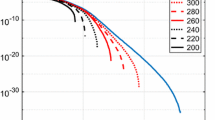Abstract
In the present paper, we have developed a least-squares minimization approach to estimate simultaneously the depth and the width of a buried 2D thin sheet from moving average residual gravity anomalies using the window-curves method. The method involves fitting the 2D thin sheet model convolved with the same moving average filter as applied to the observed data. As a result, our method can be applied not only to residuals but also to the Bouguer gravity data. A scheme for analysis of gravity data has been formulated to determine the model parameters of the thin sheet. The method is applied to synthetic data with and without random errors and tested on a field example from Egypt.










Similar content being viewed by others
References
Abdelrahman EM, El-Araby TM (1993) A least-squares minimization approach to depth determination from moving average residual gravity anomalies. Geophysics 59:1779–1784
Abdelrahman EM, El-Araby TM (1996) Shape and depth solutions from moving average residual gravity anomalies. J Appl Geophys 36:89–95
Abdelrahman EM, El-Araby HM, El-Araby TM, Abo-Ezz ER (2001a) Three least-squares minimization approaches to depth, shape, and amplitude coefficient determination from gravity data. Geophysics 66:1105–1109
Abdelrahman EM, El-Araby TM, El-Araby HM, Abo-Ezz ER (2001b) A new method for shape and depth determinations from gravity data. Geophysics 66:1774–1778
Abdelrahman EM, Essa KS, Abo-Ezz ER, Soliman KS (2006) Self-potential data interpretation using standard deviation of depths computed from moving average residual anomaly. Geophys Prospect 54:1–16
Abdelrahman EM, Abo-Ezz ER, Soliman KS, EL-Araby TM, Essa KS (2007a) A least-squares window curves method for interpretation of magnetic anomalies caused by dipping dike. Pure Appl Geophys 164:1027–1044
Abdelrahman EM, EL-Araby TM, Soliman KS, Essa KS, Abo-Ezz ER (2007b) Least-squares minimization approaches to interpret total magnetic anomalies due to spheres. Pure Appl Geophys 164:1045–1056
Blakely RJ, Simpson RW (1986) Approximating edges of source bodies from magnetic or gravity anomalies. Geophysics 51:1494–1498
Cordell L, Henderson RG (1968) Iterative three-dimensional solution of gravity anomaly data using a digital computer. Geophysics 33:596–601
Griffin WR (1949) Residual gravity in theory and practice. Geophysics 14:39–58
Hinze WJ, von Frese RRB, Saad AH (2013) Gravity and magnetic exploration: principles, practices and applications. Cambridge University Press, New York
Holstein H, Fitzgerald D, Anastasiades C (2010) Gravi-magnetic anomalies of uniform thin polygonal sheets. In: 72nd European Association of Geoscientists and Engineers conference & exhibition incorporating SPE EUROPEC, Barcelona, Spain, 14–17
Klingele EE, Marson I, Kahlem HG (1991) Automatic interpretation of gravity gradimetric data in two dimensions: vertical gradient. Geophys Prospect 39:407–434
Mackleod IN, Jones K, Dai TF (1993) 3-D analytical signal in the interpretation of total magnetic field data at low magnetic latitudes. Explor Geophys 24:679–688
Marson I, Klingele EE (1993) Advantages of using the vertical gradient of gravity for 3-D interpretation. Geophysics 58:1588–1595
Mehanee S (2014) Accurate and efficient regularized inversion approach for the interpretation of isolated gravity anomalies. Pure Appl Geophys 171:1897–1937
Nabighian MN (1972) The analytical signal of two-dimensional magnetic bodies with polygonal cross-section: its properties and use for automated anomaly interpretation. Geophysics 37:507–517
Nabighian MN (1974) Additional comments on the analytical signal of two-dimensional magnetic bodies with polygonal cross-section. Geophysics 39:85–92
Pick M, Picha J, Vyskocil V (1973) Theory of the earth’s gravity field. Academia Publishing House of the Czechoslovak Academy of Sciences, Prague, p. 538
Press WH, Flannery BP, Teukolosky SA, Vetterling WT (1986) Numerical recipes, the art of scientific computing. Cambridge University Press, Cambridge
Reid AB, Allsop JM, Granser H, Millett AJ, Somerton IW (1990) Magnetic interpretation in the three dimensions using Euler deconvolution. Geophysics 55:80–91
Skeels DC (1963) An approximation solution of the problem of maximum depth in gravity interpretation. Geophysics 28:724–735
Sultan SA, Santos FAM, Hellaly AS (2011) Integrated geophysical interpretation for the area located at the eastern part of Ismailia Canal, Greater Cairo, Egypt. Arab J Geosci 4:735–753
Talwani M, Worze JL, Landisman M (1959) Rapid gravity computations for two-dimensional bodies with applications to the Mendocino submarine fracture zone. J Geophys Res 64:49–59
Tannert JG (1967) An automated method of gravity interpretation. Geophys J R Astron Soc 13:339–347
Acknowledgments
The authors would like to thank the editors and a capable reviewer for their excellent suggestions and thorough review that improved our original manuscript. E. M. Abdelrahman wishes to express his sincere thanks to Prof. Ahmed Abukhadra and Prof. Nabil Aboulela, Geology Department, Faculty of Science, Cairo University, for their keen interest and constant encouragement.
Author information
Authors and Affiliations
Corresponding author
Rights and permissions
About this article
Cite this article
Abdelrahman, E...M., Gobashy, M.M., Essa, K.S. et al. A least-squares minimization approach to interpret gravity data due to 2D horizontal thin sheet of finite width. Arab J Geosci 9, 515 (2016). https://doi.org/10.1007/s12517-016-2537-0
Received:
Accepted:
Published:
DOI: https://doi.org/10.1007/s12517-016-2537-0




